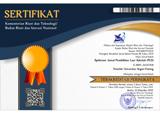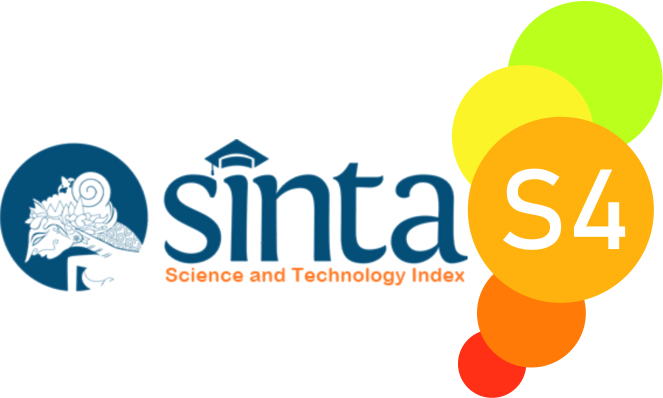The Relationship Between the Family Communication and Talking Early Children at the Pisang Village Kinali Districts Pasaman Barat
 ), Ismaniar Ismaniar(2),
), Ismaniar Ismaniar(2), (1) Universitas Negeri Padang
(2) Universitas Negeri Padang
 Corresponding Author
Corresponding Author
DOI : https://doi.org/10.24036/spektrumpls.v8i4.110145
Full Text:
 Language : en
Language : en
Abstract
This research was motivated by the low speaking ability of early childhood in Pisang Village, Kinali District, Pasaman Regency. It is suspected that one of the reasons is because the communication applied in the family is not quite right. This study aims to: 1) describe the communication that occurs in the family; 2) describe early childhood speech skills; and 3) looking at the relationship between communication within the family and the speaking ability of aged children in Pisang Village, Kinali District, West Pasaman Regency. This research is correlational quantitative research. The population in this study were 26 housewives who had children aged 4-5 years. The sample amounted to 19 people with sampling using a simple random sampling technique. The data collection technique used a questionnaire and a check for the observation of the development of speech in early childhood. The data obtained were analyzed using descriptive analysis and the correlation formula of the Sperman Rho correlation. The results of this study indicate: 1) the communication that occurs within the family in Pisang Village is in the wrong category; 2) the speaking ability of early childhood in Kampung Pisang is still low; and 3) there is a significant relationship between communication within the family and the speaking ability of early childhood in Pisang Village, Kinali District, West Pasaman Regency. Research suggestions are: 1) it is hoped that the family can implement good, dynamic, intensive, and harmonious communication with children, to improve their speaking ability in children; and 2) it is hoped that further researchers will be able to examine other variables that affect the development of children's self-speech abilities
Keywords: communication, speech application, early childhood, family education
References
Allen, K. E. & M. L. (2010). Profil Perkembangan Anak. Jakarta: Indeks.
Arikunto, S. (2016). Prosedur Penelitian: Suatu Pendekatan Praktik. Jakarta: Rineka Cipta.
Astuti, T. (2018). Hubungan pola komunikasi orangtua terhadap perkembangan berbicara anak di taman kanak-kanak. JRTI: Jurnal Riset Tindakan Indonesia, 3(2), 88–95.
Bahri, S. (2014). Pola Asuh Orang Tua dan Komunikasi dalam Keluarga. Jakarta: Rineka Cipta.
Beach, D. S. (1998). Personel: The Management of People at Work. New York: Macmillan Publishing Co.
Calista, R., Yeni, I., & Pransiska, R. (2019). Hubungan Pola Komunikasi Orang Tua terhadap Perkembangan Berbicara Anak di Raudhatul Athfal Ikhlas Gunung Pangilun Padang. Journal Pendidikan Tambusai, 3(6), 1632–1638.
Ciptarja, B. (2008). How to teach Your Baby Talk: Bagaimana Mengajar Bayi Berbicara. Yogyakarta: Penerbit Andi.
Darmawan, C. (2017). Komunikasi dan interaksi keluarga. Pendidikan Keluarga, 3(1), 1–19.
Depdiknas. (2001). Kamus Besar Bahasa Indonesia. Jakarta: Balai Pustaka.
Desmita. (2014). Psikologi Perkembangan Peserta Didik. Bandung: Remaja Rosdakarya.
Hasibuan, M. (2011). Manajemen Sumber Daya Manusia. Jakarta: Bumi Aksara.
Hurlock, E. B. (2013). Psikologi perkembangan: Suatu Pendekatan Sepanjang Rentang Kehidupan. Jakarta: Penerbit Erlangga.
Ismaniar, & Hazizah, N. (2019). Buku Ajar Pelatihan Kreativitas Deu-coupage bagi Pendidik PAUD. https://doi.org/10.31227/osf.io/6urtg
Ismaniar, I. (2020). Model Pengembangan Membaca Awal Anak: Berbasis Optimalisasi Pemanfaatan Lingkungan Keluarga. Padang: Jurusan Pendidikan Luar Sekolah.
Ismaniar, I., Jamaris, J., & Wisroni, W. (2018). Pentingnya Pemahaman Orang Tua tentang Karakteristik Pembelajaran AUD dalam Penerapan Model Environmental Print Berbasis Keluarga untuk Meningkatkan Kemampuan Membaca Awal Anak. KOLOKIUM: Jurnal Pendidikan Luar Sekolah, 6(2), 93–100. https://doi.org/10.24036/kolokium-pls.v6i2.9
Madyawati, L. (2016). Strategi Pengembangan Bahasa pada Anak. Jakarta: Kencana Prenada Media Group.
Mansur. (2009). Pendidikan anak Usia Dini dalam Islam. Yogyakarta: Pustaka Pelajar.
Mulyana, D. (2005). Ilmu Komunikasi: Suatu Pengantar. Bandung: Remaja Rosdakarya.
Mussen. (2006). Perkembangan dan Kepribadian Anak. Jakarta: Arcan Noor.
Nurbiana, D. D. (2019). Metode Pengembangan Bahasa. Jakarta: Universitas Terbuka.
Pangestuti, A. G. (2014). Studi Deskriptif Kemampuan Berbicara Anak Taman Kanak-Kanak Kelompok B di TK Aisyiah Bustanul Athfal Karangbawang Kecamatan Ajibarang Kabupaten Banyumas. Universitas Muhammadiyah Purwokerto.
Porwadarminta, W. J. S. (2008). Kamus Besar Bahasa Indonesia. Jakarta: Balai Pustaka.
Rofiq, A., & Nihayah, I. (2018). Komunikasi Sebagai Modal Utama Orang Tua Dalam Pembentukan Kepribadian Anak. (December). https://doi.org/10.31219/osf.io/2cxyt
Soetjiningsih, C. H. (2014). Perkembangan Anak. Jakarta: Prenada Media Group.
Sugiyono. (2017). Metode Penelitian Kuantitatif, Kulaitatif, dan R&B. Bandung: Alfabeta.
Utami, M. (2013). Pendidikan Anak Usia Dini. Jakarta: Universitas Negeri Jakarta.
Waxley, K. N. & Yukl, G. A. (2005). Perilaku Organisasi dan Psikologi. Jakarta: Rineka Cipta.
 Article Metrics
Article Metrics
 Abstract Views : 340 times
Abstract Views : 340 times
 PDF Downloaded : 77 times
PDF Downloaded : 77 times
Refbacks
- There are currently no refbacks.

This work is licensed under a Creative Commons Attribution-NonCommercial 4.0 International License.



